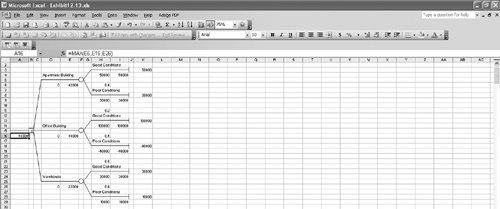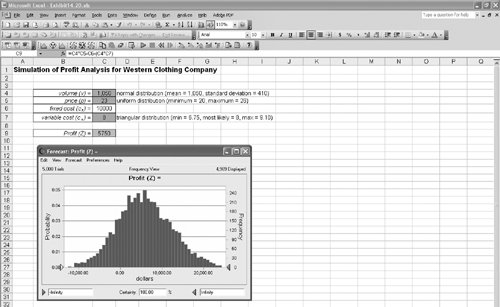Learning Features
| This ninth edition of Introduction to Management Science includes many features that are designed to help sustain and accelerate the student's learning of the material. Some of these features remain from the previous editions while others are new to this edition. Several of the strictly mathematical topicslike the simplex and transportation solution methodsare on the accompanying CD-ROM. This frees up text space for additional modeling examples in several of the chapters, allowing more emphasis on computer solutions with Excel spreadsheets, and added additional homework problems. In the following sections, we will summarize these and other learning features that appear in the text. Text OrganizationAn important objective is to have a well-organized text that flows smoothly and follows a logical progression of topics, placing the different management science modeling techniques in their proper perspective. The first 10 chapters group together those chapters related to mathematical programming that can be solved using Excel spreadsheets, including linear, integer, nonlinear, and goal programming as well as network techniques. Within these mathematical programming chapters the traditional simplex procedure for solving linear programming problems mathematically is located on the CD-ROM that accompanies this text. It can still be covered by the student on the computer as part of linear programming or it can be excluded, without leaving a "hole" in the presentation of this topic. The integer programming mathematical branch and bound solution method is also on the CD-ROM. In Chapter 6, on the transportation and assignment problems, the strictly mathematical solution approaches, including the northwest corner, VAM, and steppingstone methods , are also on the accompanying CD-ROM. Since transportation and assignment problems are specific types of network problems, the two chapters that cover network flow models and project networks that can be solved with linear programming, as well as traditional model-specific solution techniques and software, follow Chapter 6 on transportation and assignment problems. In addition, in Chapter 10, on nonlinear programming, the traditional mathematical solution techniques, including the substitution method and the method of Lagrange multipliers, are on the CD-ROM. Chapters 11 through 14 include topics generally thought of as being probabilistic, including probability and statistics, decision analysis, queuing, and simulation. A module on Markov analysis is on the accompanying CD-ROM. Also, a module on game theory, is on the CD-ROM. Forecasting in Chapters 15 and inventory in Chapter 16 are both unique topics related to operations management. New Topics and Sections in This EditionIn an effort to keep the book current and abreast of contemporary trends in management science, and especially the increased emphasis on model development and solution with Excel spreadsheets, several chapters have been altered to include new sections. Specifically, Chapter 8, on project management, has been completely rewritten to focus on activity-on-node networks and Microsoft Project. Also included are new sections Project Planning, The Project Team, Scope Statement, Work Breakdown Structure, Responsibility Assignment Matrix, Project Scheduling, and Project Control. Excel SpreadsheetsThis new edition continues to emphasize Excel spreadsheet solutions of problems. Spreadsheet solutions are demonstrated in all the chapters in the text (except for Chapter 2, on linear programming modeling and graphical solution), for virtually every management science modeling technique presented. These spreadsheet solutions are presented in optional subsections, allowing the instructor to decide whether to cover them. The text includes over 175 Excel spreadsheet screens, most of which include reference callout boxes that describe the solution steps within the spreadsheet. Files that include all the Excel spreadsheet model solutions for the examples in the text are included on the accompanying CD-ROM, and can be easily downloaded by the student to determine how the spreadsheet was set up and the solution derived, and to use as templates to work homework problems. In addition, Appendix B at the end of the text provides a tutorial on how to set up and edit spreadsheets for problem solution. Following is an example of one of the Excel spreadsheet files (from Chapter 3) that is available on the CD-ROM accompanying the text.  Spreadsheet "Add-Ins"Several spreadsheet add-in packages are provided on the CD-ROM that is packaged with every copy of this text, as follows: Excel QMFor some management science topics, the Excel formulas that are required for solution are lengthy and complex and, thus, are very tedious and time-consuming to type into a spreadsheet. In several of these instances in the book, including Chapter 6 on transportation and assignment problems, Chapter 12 on decision analysis, Chapter 13 on queuing, Chapter 15 on forecasting, and Chapter 16 on inventory control, a spreadsheet "add-in" called Excel QM is demonstrated. These add-ins provide a generic spreadsheet set-up with easy-to-use dialog boxes and all of the formulas already typed in for specific problem types. Unlike other "black box" software, these add-ins allow users to see the formulas used in each cell . The input, results, and the graphics are easily seen and can be easily changed, making this software ideal for classroom demonstrations and student explorations. Following is an example of an Excel QM file (from Chapter 13) that is on the CD-ROM that accompanies the text.  Premium Solver for EducationThis is an upgraded version of the standard Solver that comes with Excel. TreePlanAnother spreadsheet add-in program that is demonstrated in the text is TreePlan , a program that will set up a generic spreadsheet for the solution of decision-tree problems in Chapter 12 on decision analysis. This is also provided on the accompanying CD-ROM. Following is an example of one of the TreePlan files (from Chapter 12) that is on the text CD-ROM.  Crystal BallStill another spreadsheet add-in program that is included on the accompanying CD-ROM and demonstrated in the book is Crystal Ball . Crystal Ball is demonstrated in Chapter 14 on simulation and shows how to perform simulation analysis for certain types of risk analysis and forecasting problems. Following is an example of one of the Crystal Ball files (from Chapter 14) that is on the text CD-ROM.  QM for Windows Software Package:QM for Windows is the computer package that is included on the text CD-ROM and that many students and instructors will prefer to use with this text. This software is very user -friendly, requiring virtually no preliminary instruction except for the "help" screens that can be accessed directly from the program. It is demonstrated throughout the text in conjunction with virtually every management science modeling technique, except simulation. The text includes 50 QM for Windows screens used to demonstrate example problems. Thus, for most topics problem solution is demonstrated via both Excel spreadsheets and QM for Windows. Files that include all the QM for Windows solutions for examples in the text are included on the accompanying CD-ROM. Following is an example of one of the QM for Windows files (from Chapter 4) that is on the CD-ROM.  |
EAN: 2147483647
Pages: 358